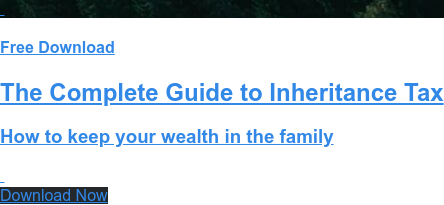Have you heard of upcycling? It’s the buzzword for giving an old item a new purpose; a new term but not really a new phenomenon. Think of car tyres as flower pots, bottles becoming lamps, a table from a door. What’s old is new again, but with a twist.
This idea of repurposing something old to give it a new use came to my mind this week as I considered the Business Property Relief (BPR) investment market. Are inheritance tax (IHT) avoidance investments simply existing IHT legislation, but upcycled?
Inheritance tax can be more punitive than either income tax or capital gains tax, as it is generally charged at 40% of the net value of an asset that has often been acquired out of income previously subject to tax. The government has made some progressive changes recently to increase the ‘nil rate band’ of £325,000 (until 2018) to £500,000 including property values, or £1M for married couples. There are many ways to mitigate these estate costs through planning, as I’ve discussed before in our ‘Keep It in the Family: Taxation of Pensions’ series.
However, investment opportunities such as those offered through Enterprise Investment Schemes (EISs) and Venture Capital Trusts (VCTs) have become increasingly publicised as an option to the more traditional IHT planning methods.
BPR provides full relief from IHT for a qualifying interest in a business, whether a sole trader, shares in a partnership, assets used in a qualifying business or shares in a qualifying company.
Business property relief legislation was originally introduced in 1976 to allow family firms to be passed down to the next generation, although recently it seems to have been refashioned into an alternative IHT avoidance scheme. While BPR is fit for purpose and many family-run enterprises use this benefit as it was intended, it seems BPR has been upcycled from a business tax relief to a professionally managed investment scheme. You no longer need to be in business to benefit from BPR. It is available as an investment product offering retail investors access to the IHT treatment of qualifying investments.
How Does BPR Work?
BPR provides full relief from IHT for a qualifying interest in a business, whether a sole trader, shares in a partnership, assets used in a qualifying business or shares in a qualifying company. There are rules, for example, the business or company must be continuing on in a qualifying trade and there are a few exclusions, such as dealing in securities and shares, making or holding investments in land or property (although property development is a qualifying activity). The current rules allow a wide range of investments, from forestry, renewable energy, and property finance businesses to asset-backed businesses like pubs, health clubs and hotels.
Any business owner can qualify, whether they are involved directly in the running of the business or just an investor. The scheme is primarily aimed at private businesses but others such as those on the Alternative Investment Market (AIM) or subscribed for under the Enterprise Investment Scheme (EIS) do also qualify, and there is no limit to the value of the relief.
As with EIS investments, schemes that qualify for BPR only need to be held for two years to realise full freedom from IHT. This is sharply reduced from the ‘seven year’ rule that applies to gifting strategies involving potentially exempt transfers.
Are BPR Schemes a Suitable Inheritance Tax Avoidance Strategy?
Like a wagon wheel coffee table or a BBQ made from a car bonnet, BPR schemes targeted specifically at IHT avoidance should only be considered when the more obvious tax planning solutions have already been utilised. As with all areas of tax law, the rules are detailed and there are pitfalls for the unwary. The type of investments that use BPR are generally regarded by tax planners as the final stop, after the basic IHT reliefs and trust options have been used, or where the need to retain control of the assets is paramount.
Whilst the benefits appear to be extremely attractive, by the very nature of investing in unquoted business there is a considerable degree of risk. For example, the potential for losses with AIM stocks is far greater compared to even our highest risk level structured portfolio model. Some schemes can be found with a lower risk profile than EIS which attracts investors with higher levels of risk tolerance.
Valuations are very difficult to ascertain and any investment losses may negate or completely outweigh any potential IHT savings achieved. Since one of the key benefits for this kind of scheme is relief from IHT after two years, investment funds bearing lower risk are inherently more attractive.
Liquidity in BPR qualifying investments may also be limited, which reduces access to capital. Whereas VCT shares are listed and tend to offer regular dividends, EIS investments are much less liquid and money is often tied in for lengthy terms until gains are realised.
What are the Legal Requirements?
BPR investments do not require any complex legal or trust structures and investors are not subject to any medical underwriting. Typically, this type of scheme would be proposed if an investor is in poor health and may not have a realistic expectation of surviving seven years. If a married person dies prior to the two-year period, their spouse can inherit the period of ownership.
Like a wagon wheel coffee table or a BBQ made from a car bonnet, BPR schemes targeted specifically at IHT avoidance should only be considered when the more obvious tax planning solutions have already been utilised.
If you are selling a business that you have held for more than two years that qualified for BPR, or likewise wish to sell BPR qualifying shares, these can be reinvested within three years in another BPR investment with immediate IHT shelter. In order to achieve the IHT savings it will be necessary to hold any BPR investments until death. Selling a BPR, even after two years, will put the proceeds back into the individual’s taxable estate.
How Much do they Cost?
The fees on managed BPR schemes are, as one might expect, usuriously high in comparison to passive funds. Annual management charges in the region of 2% to 3% and around 3.5% in terms of total costs, and that is before any form of performance fee is deducted. Don’t forget that there are often arrangement fees representing around 2% of each transaction. In the end, investors only receive returns net of costs. When costs are high, as they are in this case, intermediaries take, in my opinion, an unjustified share of the upside.
As Tim Hale put it in his post The Good, the Bad and the Ugly of VCTs and EIS…
“It is a mistake to think that these tax breaks are altruistic in nature. Their purpose is to encourage the supply of capital to these companies in the hope that they will employ more people – who will pay income tax, make NI contributions (individual and company) and pay VAT on goods bought with their wages – and that they will generate higher corporate earnings on which corporation tax can be charged. The tax breaks are provided to improve the risk-return relationship that potential investors in these companies face.”
It would be extremely rare for me to recommend a BPR investment in the event that a client’s other tax reliefs (e.g. pension, ISA, CGT) have not yet been maximised. These products should only be offered in very client specific circumstances where all other avenues have been explored, and only for those clients who meet stringent net worth and investor sophistication criteria.
Do you have an insight to share given the government’s consultation on pensions and ongoing policy and legislation associated with IHT planning? Leave a comment below to start the discussion.
This article does not constitute financial advice. Individuals must not rely on this information to make a financial or investment decision. Before making any decision, we recommend you consult your financial planner to take into account your particular investment objectives, financial situation and individual needs. Past performance is not a guide to future performance. The value of an investment and the income from it may go down as well as up and investors may not get back the amount originally invested. This document may include forward-looking statements that are based upon our current opinions, expectations and projections.







